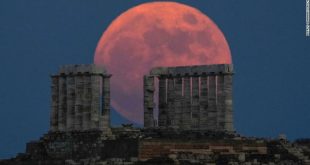Nevine al-Aref – Ahram Online
As a part of ‘Temple Conservation Project’, An Egyptian-German mission directed by Hourig Sourouzian uncovered a collection of colossi limestone pieces at the temple of Amenhotep III in Luxor on Thursday.
“Among the discovered blocks were a pair of gigantic limestone colossi of king Amenhotep III in the shape of sphinxes wearing the nemes headdress, the royal beard, and a broad collar around the neck”, said Mostafa Waziri, the Secretary General of the Supreme Council of Antiquities.
Two colossal sphinxes were found half submerged in water at the rear-end of the third pylon gateway. Pieces of the heads’ inscribed chest were also recovered during the excavation. “The beloved of Amun-Re”, was inscribed on one of the recovered pieces. Other parts of the body, which include the paws were safely removed for conservation.

The mission unearthed three busts, and three lower parts of statues of the lioness goddess Sekhmet in granodiorite. They were found at the façade of the Peristyle Court and in the Hypostyle Hall of the temple. The recovered antiquities will be reassembled and displayed in the temple.
Parts of sandstone wall decoration depicting scenes of the Heb-sed, the jubilee festival of Amenhotep III, and offering scenes to diverse deities were also unearthed. Archaeologists discovered a small granodiorite statue of an official seated with his wife, likely from the post-Amarna period, when restoration works in this temple were carried out by artists and scribes.
Column bases and foundation blocks in the Southern half of the Hypostyle Hall were also found. The blocks were engraved with scenes showing the sheer size of the hall, which was much larger than experts believed.
“The presence of this pair of colossal sphinxes attests to the beginning of the processional way leading from the third pylon to the Peristyle Court. It is where the beautiful ‘Festival of the Valley’ was celebrated each year, and the jubilee festivals of the king in the last decade of his reign”, Hourig Sourouzian, head of the German mission explained.
“Preliminary research on these colossal sphinxes reveal that they were 8 metres tall. At the moment, all discovered blocks and colossi are under restoration in an attempt to re-erect them in their original location in the temple”, Sourouzian added.
The ‘Temple of Millions of Years’ was the largest of all funerary temples on the West Bank. It was toppled by a strong earthquake in antiquity.
‘The Colossi of Memnon and Amenhotep III Temple Conservation Project’ began in 1998, under the auspices of the Ministry of Tourism and Antiquities and the German Archaeological Institute in Cairo. The project uncovered several structures, architectural remains, monumental stela. The mission managed to mount several colossal statues of the king in their original locations.






